David Harris
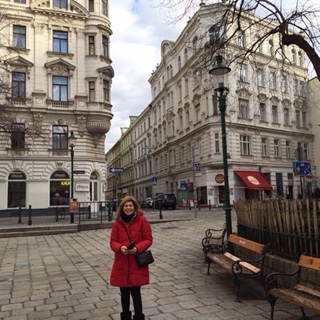
From Budapest to Vienna: A Trip About Jewish Renewal
By Barb Miller, Director of Community Building, Jewish Federation of Cincinnati
On February 3 I left for a seven-day trip to Budapest and Vienna sponsored by Da’at Travel, the same organization that is planning the 2016 Congregation and Community Mission to Israel next summer. Da’at sponsored this trip for Jewish Federation professionals so that, in the future, we could offer these types of missions so Federation donors could see firsthand the impact of their campaign dollars. Thirty percent of campaign dollars raised each year goes to support the Jewish Agency for Israel (JAFI) and the American Jewish Joint Distribution Committee(JDC), who serve numerous European and Jewish communities across the world.
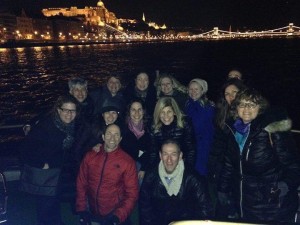
Approximately 20 Jewish communal professionals from different Federations traveled together on this most amazing and inspiring trip. Everything was perfect—from the exceptionally knowledgeable guides, to the beautiful sites, to the amazing Jewish leaders and speakers we met with, and most importantly to the incredible introductions to the Jewish Agency and JDC programs that are making such a difference in the lives of so many.
Our first stop was Budapest: Budapest was once a thriving Jewish city. In the late 1800s the approximately 250,0000 Jews there represented 25 percent of the total Hungarian Jewish population. In 1944, over 430,000 Hungarian Jews were deported to Auschwitz. Today, there are about 100,000 Jews in Hungary—the third largest Jewish population in Europe.
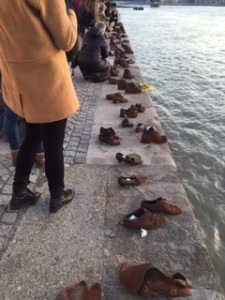
As part of our visit in Budapest we saw the very moving Shoe Memorial along the banks of the Danube River. This memorial commemorates the thousands of Jews who were shot and thrown into the Danube by the Hungarians in late 1944. This unconscionable event happened in full view of the surrounding luxury apartments and hotels. As part of our trip we also visited the Dohanyi synagogue, which was built in the 1850s and was the largest European synagogue at that time.

What was most satisfying was seeing how the Jewish Agency and the JDC invest in programs that not only support older Jews in need but also assist younger Jews who are creating new grassroots programs in a city where Judaism was erased for many years under a communist government. For instance, w
e visited a beautiful facility known as the Mozaik Jewish Community HUB. At the HUB the JDC helps Jewish NGO startups by providing young people with mentors and professional guidance on budgets, strategic plans, fundraising, and marketing. We met with millennials who designed some incredible new programs, ranging from curriculums for public schools to learn about the Holocaust through v
ideotapes of Hungarian Jewish Holocaust survivors to a curriculum that focuses not just on the Holocaust but on Jewish life prior to the war and today. We heard about another program called “Talmud, not only for Women,” and a volunteer-led program that encourages open dialogues between younger Jews and non-Jews. In the latter, Jewish volunteers go into public schools to address the stereotypes that exist about Jews in Hungary today. Those who participate reported that they often hear comments such as, “you cannot be Jewish,” “you are too pretty to be Jewish,” “your hair is not red,” or “all Jews wear a skull cap.” They indicated that most Hungarians have a perception that today there are 1 million Jews in Hungary who are either communists, bankers, or religious.
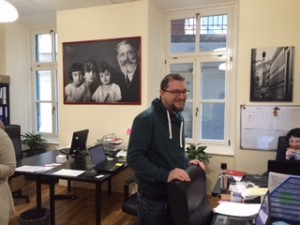
Verbal antisemitism is rampant in Hungary and the current government supports a strong undercurrent of antisemitism particularly in the media and mainstream newspapers. The financial crisis of 2008-2009 was blamed on the “Brooklyn Jews” and there is a strong push toward Conservative Nationalism. Verbal antisemitism is much higher in Hungary and Jews chose either to assimilate or to hide their identities. Most feel that it’s not possible to really be Hungarian and Jewish at the same time. The current government wants to ensure that Hungary remains a Christian country and has spent millions of dollars on a billboard campaign stating, “Refugees are not welcome here.”
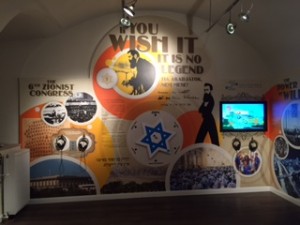
We also visited the Israeli Cultural Institute, a beautiful facility located in the heart of Budapest that brings Israel to the community. In this facility, which includes an interactive museum about Theodore Herzl, the World Zionist Organization and the Jewish Agency collaborate on a whole variety of programs. We met two of many young leaders who recently discovered their Jewish roots after participating on a Birthright trip to Israel. They now are leading programs for other Jewish young adults who also are discovering their Jewish heritage. These young people participate in a local “minyanim” program where they continue their Jewish studies, combined with community activism for over two years. Together they find a sense of community and after they participate in their local minyanim programs they join other Jewish communities in regions such as Bosnia, Bulgaria, Czech Republic, Hungary, Poland, Romania, and Serbia.
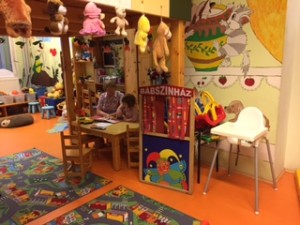
At the Balint House, or the JCC of Budapest, we spoke with participants of an intergenerational Birthright trip to Israel. This program, a collaborative partnership between the Jewish Agency and the JDC, couples young people with elderly Holocaust survivors who never had the opportunity to visit Israel. Together they meet for a year getting to know one another and then travel to Israel together. For many of these survivors traveling to Israel is their last dying wish. This experience makes a huge impact on the participants, and their families and friends, as they share their journeys together giving promise to the survivor that the Jewish people in Israel and the Jewish people in Hungary will live. In addition long-lasting relationships are formed between the survivor and the young adult before, during and after the trip.
After our visit to Budapest we went on to Vienna for two days, the city from which my husband’s mother fled in 1938, following the Anschluss. As I walked through the streets of this beautiful city, I could not imagine how my mother-in-law and her parents and brother must have felt leaving a place that had brought them so much happiness and financial success. It was apparent that they lived among are refined people and surely they must have thought they would be safe in this lovely city of music, opera, art, and coffee houses filled with Viennese pastries. Having the opportunity to actually visit my mother-in-law’s house and the memorial to all the Jews who lived in her neighborhood (the same neighborhood where Sigmund Freud lived), was a personal highlight of this trip, which I talk more about here.
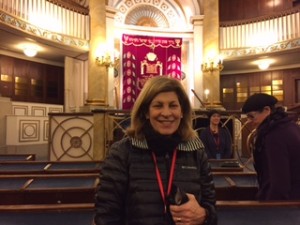
We visited the Vienna Temple, which still functions today, serving the approximately seven thousand Jews of Vienna. It was not destroyed during Krystallnacht because it was so close to the adjoining buildings that they would have been burnt to the ground as well had the synagogue been lit on fire. The Memorial to the Austrian
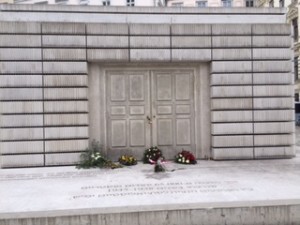
Victims of the Holocaust is a cement library with books turned backwards on shelves and a door that does not allow entry. The memorial is surrounded by the names of all the concentration camps.
A highlight in Vienna was meeting three young adults, all Iranian Jews, who fled Iran with visas from Austria. Aided by the JDC, they wait to enter the United States while temporarily residing in Austria. They are among the 25 Iranian in Vienna being assisted by the JDC. The JDC has always been committed to helping Jews in need wherever they may be, and I am so proud to know that they are our Federation’s partners.
I am now back at the office catching up on my work and my jet lag. How in the world do I communicate what I felt and experienced while on this trip? It comes down to this:
- I am proud of the work that I and my colleagues and the many, many generous volunteers of the Jewish Federation of Cincinnati do to take care of Jews around the world, no matter where they live.
- There are some truly innovative spaces and programs that I saw in Budapest that I would love to replicate in Cincinnati.
- Ask not what we can do for Israel; instead, think about what Israel has done for us—not just as a place of refuge but as a place that strengthens the Jewish identities of young people everywhere; and
- I hope that in the near future many members of our community will consider going on a similar trip to Budapest and Vienna or Ukraine and Bulgaria or Berlin and Bulgaria, so they can better understand and truly feel the same sense of pride I have for the support we provide and the work we do for our “kin.”

